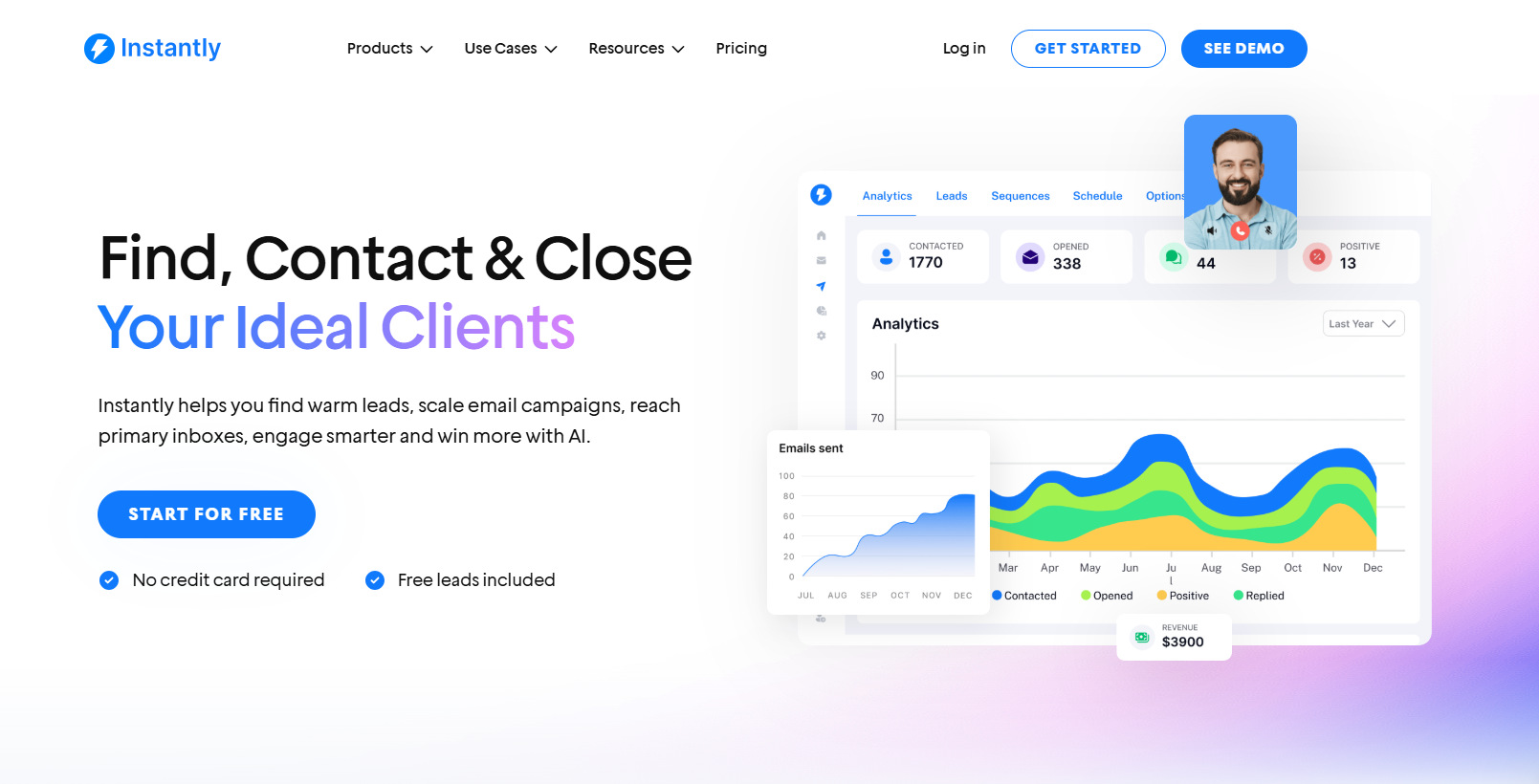Email providers keep score. In 2025, the sender score doesn’t sit quietly in the background. It has become the gatekeeper. If your score holds up, you reach real people. If it slips, your campaigns are flagged before anyone even sees them.
You might notice something subtle at first: reply rates start to sink, even though your content stays sharp. Maybe a few meetings disappear from your pipeline. Deals stall out. “Delivered” still shows up in the dashboard, but behind the scenes, fewer prospects open, fewer conversations get started, and revenue starts to lag.
It’s rarely an accident. Each ignored message, every invalid address, every small spike in spam complaints chips away at your reputation. Now that providers share sender data across Gmail, Outlook, and Yahoo, a single misstep can follow you everywhere.
Ignoring sender score means you risk burning your time, budget, and credibility with every missed conversation. Staying ahead starts by knowing your score and acting before the damage spreads.
What Is Sender Score?
Sender score is your reputation, distilled into a single number. Providers look at this metric to decide whether your emails hit the inbox or end up in spam. Most treat it as a trust signal—if you keep a strong score, your messages move past the first line of defense. If you drop, your emails get filtered out long before anyone sees your offer.
Think of sender score like a credit rating, but for your email domain. Every time you send, mailbox providers evaluate past behavior: how many people engaged, how many marked you as spam, how often you hit invalid addresses. The score typically ranges from 0 to 100. Higher is always better.
Many teams confuse sender score with domain reputation or IP reputation. Here’s the difference:
- Sender score blends historical data from your sending domain, behavior patterns, and engagement.
- Domain reputation tracks how mailbox providers see your domain over time, often behind the scenes.
- IP reputation measures the quality of the server’s address used to send your emails.
In 2025, email providers rely less on fixed IPs or static rules. Modern systems run dynamic checks on sender score, pulling real engagement and complaint data across Gmail, Outlook, Yahoo, and more.
It’s not enough to swap IPs or domains if things go south. The sender score follows your sending domain everywhere.
Providers raise the bar every year. A healthy sender score is now the baseline. If you want to break through tougher filters and build a reliable pipeline, this number sets your ceiling.
Instantly gives you a live view of your sender score alongside every campaign. You get a direct read on reputation, engagement, and risk, all in one place. With instant feedback, you adjust before a problem snowballs—and keep your deliverability strong.
How Sender Score Is Calculated in 2025
Sender score isn’t based on a single event or one bad campaign. It’s a running calculation built from the patterns mailbox providers see over time. The core data points haven’t changed much, but the way providers weigh and connect them has evolved fast.
The main factors in 2025:
- Spam complaints: Every time a recipient clicks “mark as spam,” providers take note. Just a handful can push your score down, especially if you’re sending high volumes.
- Bounce rates: Invalid or non-existent addresses tell providers your list hygiene needs work. Too many bounces—especially hard bounces—signal that you’re not maintaining your data.
- Engagement: Opens, clicks, replies, and forwards all work in your favor. The more real interaction you get, the higher trust you build. Providers now lean heavily on positive engagement as a key factor.
- Sending history and volume: Consistency matters. Regular sending patterns build trust. Surges or lulls stand out. Sudden spikes trigger suspicion and lower your score.
- Blacklists: If your domain or IP lands on a major blocklist, your sender score drops—sometimes overnight. Providers often pull in dozens of public and private lists as part of their calculation.
- Spam trap hits: These are designed to catch senders who use old, purchased, or scraped lists. Hitting a spam trap shows the provider you’re not following best practices, and your score takes an immediate hit.
- Authentication: Missing or misconfigured authentication—SPF, DKIM, DMARC—raises red flags. Providers now require passing all three for full score potential.
In the past, these factors lived in silos. Now, major providers use machine learning to connect them. For example, Microsoft and Gmail share and cross-reference complaint and engagement data. A spike in spam complaints on one platform can lower your score everywhere.
Most public “sender score” services give an aggregate. But each provider uses its own secret recipe. That’s why watching your own engagement and complaints is as important as checking third-party scores.
Instantly’s inbox placement tests and domain health monitoring track all these factors in real time. Engagement dips, complaint spikes, or blacklisting get surfaced before they do real damage.

With up-to-date data, you can respond fast to fix list hygiene, adjust volume, or jump on technical errors before your sender score suffers.
Why Sender Score Matters More Than Ever
Sender score is the dividing line between seeing results from email and seeing campaigns disappear without a trace. In 2025, its influence stretches further than most senders expect. Mailbox providers no longer act in isolation. When your sender score drops, the effect ripples across providers at once.
A low score puts you on the wrong side of every filter. The result? Fewer emails reach the inbox, and even fewer get opened by decision-makers. You lose more than opens—meetings drop, revenue lags, and trusted relationships slip through your fingers. Sales teams feel this before the dashboard shows it: calendars emptier, deals stalling, once-reliable prospects going quiet.
Here’s the reality: good deliverability is now a moving target. What worked last quarter might fail today if your sender score slips by even a few points. The shift is especially sharp for B2B teams relying on volume and fast turnarounds.
What’s worse? Most teams find out too late. By the time reply rates crash or a campaign tanks, the underlying reputation damage is weeks old. Recovery takes time—sometimes months—while missed opportunities pile up.
Instantly puts that risk in plain view. Domain health alerts and deliverability tracking highlight trouble before it snowballs. You see which campaigns raise your risk, which lists need cleaning, and how your sending patterns affect reputation across Gmail, Outlook, and Yahoo simultaneously.
Sender score is the new gatekeeper for the sales pipeline, not just for marketing. Treating it as an urgent, revenue-facing metric sets strong teams apart and keeps your emails working when everyone else is stuck in review cycles.
Top Mistakes That Destroy Sender Score

Mistakes that hurt sender score often slip in quietly, even on experienced teams. Email reputation is easy to damage and slow to fix, especially as filters get smarter every year.
Here are the most common traps and the habits that set them in motion.
Sending to Purchased or Scraped Lists
The quickest way to sink your sender score is by blasting purchased or scraped email lists. Providers are watching for signs you’ve skipped proper consent: low engagement rates, an instant spike in unsubscribes, or sudden complaints from contacts who have never heard of you.
Modern algorithms spot these patterns fast. It only takes a handful of sends to poison reputation across multiple providers—not just where you sent, but everywhere your domain tries to land.
If you want to keep your score strong, build your list the slow way. Use double opt-in forms, verify signups, and remove any addresses that bounce or never engage.
Skipping List Hygiene and Bounce Management
List hygiene slips quietly. Maybe you keep adding new contacts, but forget to remove those who never open a message. Or you keep sending to addresses that bounced last time, hoping it’s just a fluke. Each bounce and ignored send is a negative mark.
Over time, high bounce rates and a growing pile of inactive subscribers convince providers that you’re no longer wanted in the inbox. Good hygiene is ongoing. Clean out invalid addresses quickly, and set up sunset policies for inactive users (try 60-90 days with no engagement).
Sudden Surges in Sending Volume
Volume spikes look suspicious. You might want to scale fast (maybe you’re launching a campaign or testing a new segment), but when providers see a jump from 500 to 5,000 overnight, they flag your entire operation. Even legitimate growth can look risky if it’s not steady. Once filters throttle you, it’s tough to rebuild trust.
The safest path is gradual, predictable increases. Ramp up volume only as engagement holds steady. If you need to scale, use multiple warmed-up domains and stagger sends.
Ignoring Authentication Protocols
Technical basics trip up even experienced teams. Missing SPF, DKIM, or DMARC records are a red flag. Every provider expects all three, correctly aligned every single time you send. Without them, your emails land in spam, even if your content is perfect and your audience is eager to hear from you.
Don’t treat authentication as a one-and-done setup. Review and test your records regularly, especially after any domain change.
Overlooking Engagement and Content Signals
Content doesn’t live in a vacuum. Providers judge your sender score by what real people do with your messages. Repeatedly sending to disengaged lists, using the same tired subject lines, or pushing aggressive offers leads to a slow drip of lower opens and faster deletions. All it takes is a few poorly received campaigns to start a downward spiral.
Keep your messaging targeted and fresh. Test new ideas on smaller segments before scaling up. Monitor not just open rates but replies and positive engagement.
Technical Gaps and Poor Infrastructure
Small technical details often get overlooked, especially as teams scale across domains or add new tools. Problems like missing PTR records, mismatched sending domains, or inconsistent MX records all leave a trail for spam filters to follow. Even SSL certificate issues can flag your sends as risky.
Technical mistakes rarely announce themselves. Set monthly reviews for all records and domain health checks to surface silent errors early. The sooner you catch a drift in your infrastructure, the easier it is to stay in the filters’ good graces.
How to Check and Monitor Your Sender Score
Seeing your sender score should be as routine as checking campaign stats. But too many teams fly blind, relying on guesses or lagging third-party tools. That’s where cracks in deliverability start.
Start with the basics: public tools run your domain through hundreds of signals and serve up a score. It’s a fast way to spot big problems. Google Postmaster Tools and Microsoft SNDS go deeper. Postmaster shows reputation, spam rates, and authentication health for Gmail. SNDS does the same for Microsoft. These dashboards give clear, daily signals if you know what to look for.
But number-watching isn’t enough if you miss context. Maybe a public score nudges lower, but your engagement rates hold steady. Maybe deliverability tanks, but “sender score” stays mid-range. Providers have their own secret recipes, so you need more than one view. Watch your open and reply rates alongside your score. Sudden declines are early warnings that some filter has moved against you.
That’s where Instantly.ai makes monitoring simple. Our domain health analytics track sender score, authentication status, blacklists, and engagement, all in one place.

You see changes as they happen, not weeks later. If bounce rates jump or a misconfigured record appears, you get alerted to act before issues spiral. Managing multiple domains or clients? Instantly shows everything side by side. No more switching tabs or missing a hidden red flag.
Remember to check your sender score before every campaign, after every major list change, and whenever you see a dip in replies. With the right feedback loops, you fix problems before they sink performance, and keep your emails landing directly in inboxes. Try Instantly for free today.
Key Takeaways
Sender score is now the first thing standing between your emails and real results. Keeping your reputation strong takes ongoing attention, not guesswork or outdated tools. Strong teams make the sender score part of their workflow—monitoring, adjusting, and protecting it every day.
Here’s what matters most:
- List quality and consent drive trust—avoid purchased data at all costs.
- Consistent sending habits and strong engagement keep your score high.
- Authentication, list hygiene, and technical setup are non-negotiable.
- Public dashboards help, but real-time, multi-factor monitoring uncovers issues sooner.
- Fast action on bounce rates or complaints keeps pipeline flowing.
Sender score is your pipeline’s foundation. Instantly.ai makes monitoring and protecting your sender score effortless, so your emails reach real people, every time. Start your free Instantly trial today.




